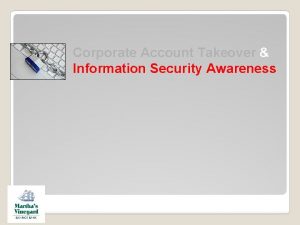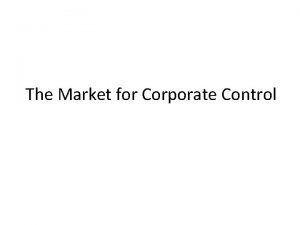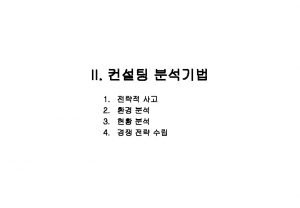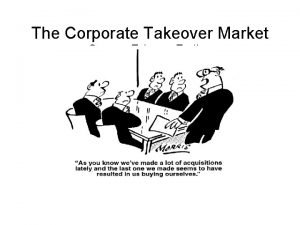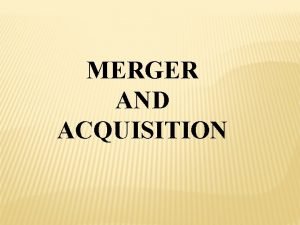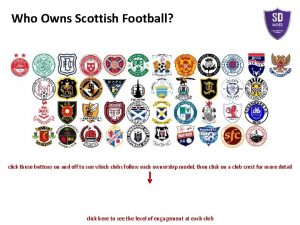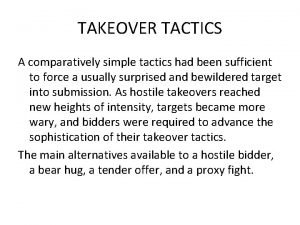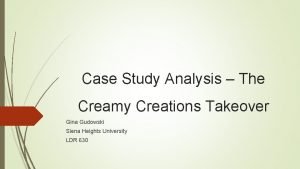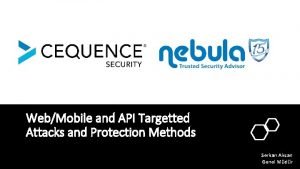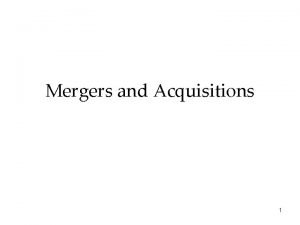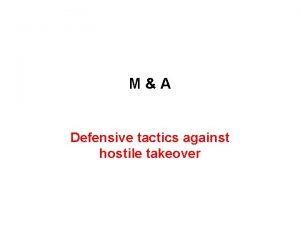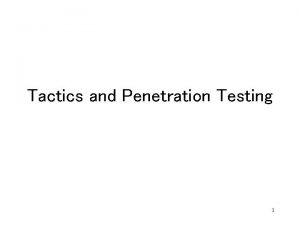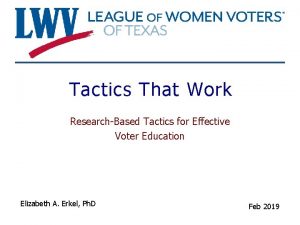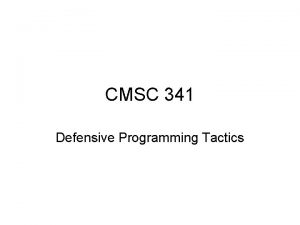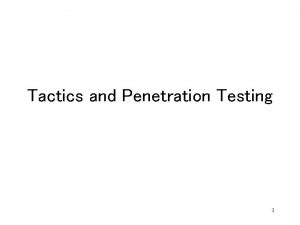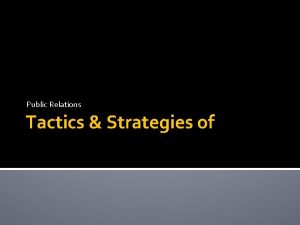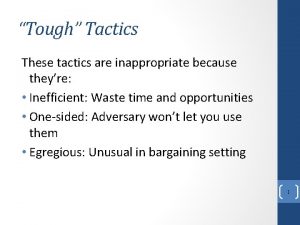The Corporate Takeover Market Common Takeover Tactics Takeover

























- Slides: 25

The Corporate Takeover Market Common Takeover Tactics, Takeover Defenses, and Corporate Governance

Treat a person as he is, and he will remain as he is. Treat him as he could be, and he will become what he should be. —Jimmy Johnson

Exhibit 1: Course Layout: Mergers, Acquisitions, and Other Restructuring Activities Part I: M&A Environment Part II: M&A Process Part III: M&A Valuation and Modeling Part IV: Deal Structuring and Financing Part V: Alternative Business and Restructuring Strategies Ch. 1: Motivations for M&A Ch. 4: Business and Acquisition Plans Ch. 7: Discounted Cash Flow Valuation Ch. 11: Payment and Legal Considerations Ch. 15: Business Alliances Ch. 2: Regulatory Considerations Ch. 5: Search through Closing Activities Ch. 8: Relative Valuation Methodologies Ch. 12: Accounting & Tax Considerations Ch. 16: Divestitures, Spin-Offs, Split-Offs, and Equity Carve-Outs Ch. 3: Takeover Tactics, Defenses, and Corporate Governance Ch. 6: M&A Postclosing Integration Ch. 9: Financial Modeling Basics Ch. 13: Financing the Deal Ch. 17: Bankruptcy and Liquidation Ch. 10: Private Company Valuation Ch. 14: Applying Financial Models to Deal Structuring Ch. 18: Cross-Border Transactions

Current Lecture Learning Objectives Providing students with an understanding of • Corporate governance and its role in protecting stakeholders in the firm; • Factors external and internal to the firm affecting corporate governance; • Common takeover tactics employed in the market for corporate control and when and why they are used; and • Common takeover defenses employed by target firms and when and why they are used.

Alternative Models of Corporate Control • Market model applies when: – Capital markets are liquid – Equity ownership is widely dispersed – Board members are largely independent – Ownership & control are separate – Financial disclosure is high – Shareholder focus more on short-term gains • Prevalent In U. S. and U. K. • Control model applies when: – Capital markets are illiquid – Ownership is heavily concentrated – Board members are largely “insiders” – Ownership & control overlap – Financial disclosure limited – Shareholder focus more on long-term gains • Prevalent in Europe, Asia, & Latin America

Factors Affecting Corporate Governance: Market Model Perspective External to Firm Legislation: 1933 -34 Securities Acts Dodd-Frank Act of 2010 Sherman Anti-Trust Act External to Firm Regulators: SEC Justice Department FTC Internal to Firm Board of Directors Management Internal Controls Incentive Systems Corporate Culture & Values Takeover Defenses Bond Covenants External to Firm Institutional Activism: Pension Funds (Calpers) Mutual Funds Hedge Funds External to Firm Market for Corporate Control: Proxy Contests Hostile Takeovers

Internal Factors: Board of Directors and Management • Board responsibilities include: --Review management proposals/advise CEO --Hire, fire, and set CEO compensation --Oversee management, corporate strategy, and financial reports to shareholders • Good governance practices include: --Separation of CEO and Chairman of the Board --Boards dominated by independent members --Independent members serving on the audit and compensation committees

Internal Factors: Controls & Incentive Systems • Dodd-Frank Act (2010): -- Gives shareholders of public firms nonbinding right to vote on executive compensation packages --Public firms must have mechanism for recovering compensation 3 -yrs prior to earnings restatement • Alternative ways to align management and shareholder objectives – Link stock option exercise prices to firm’s stock price performance relative to the overall market – Key managers should own a significant portion of the firm’s outstanding shares

Internal Factors: Corporate Culture & Values • Corporate culture refers to a common set of values, traditions, and beliefs that influence management and employee behavior within a firm. • The desired culture for the new organization can be promoted through – Clear and consistent communication to all employees of what is appropriate and what is not – Senior management consistently displaying the desired behaviors – Reward systems that foster desired behaviors while penalizing undesirable conduct • Trust in a new organization is undermined when there is ambiguity about the new organization’s culture/identity.

External Factors: Legislation • Federal and state securities laws – Securities Acts of 1933 and 1934 – Williams Act (1968) • Insider trading laws • Anti-trust laws – Sherman Act (1890) – Clayton Act (1914) – Hart-Scott-Rodino Act (1976) • Dodd-Frank Act (2010)

External Factors: Regulators • • Securities and Exchange Commission (SEC) Justice Department Federal Trade Commission (FTC) Public Company Accounting Oversight Board (PCAOB) • Financial Accounting Standards Board (FASB) • Financial Stability Oversight Council (FSOC)

External Factors: Institutional Activism • Pension funds, mutual funds, and insurance companies • Ability to discipline management often limited by amount of stock can legally own in a single firm • Investors with huge portfolios (e. g. , TIAA-CREF, California Employee Pension Fund) can exert significant influence • Recent trend has been for institutional investors to simply withhold their votes

External Factors: Market for Corporate Control • Changes in control can result from hostile takeovers or proxy contests • Management may resist takeover bids to – Increase the purchase price (Shareholders’ Interests Theory) or – Ensure their longevity with the firm (Management Entrenchment Theory) • Takeovers may – Minimize “agency costs” and – Transfer control to those who can more efficiently manage the acquired assets

Discussion Questions 1. Do you believe corporate governance should be narrowly defined to encompass shareholders only or more broadly to incorporate all stakeholders? Explain your answer. 2. Of the external factors impacting corporate governance, which do you believe is likely to be the most important? Be specific.

Market for Corporate Control: Alternative Takeover 1 Tactics • Friendly deals (Target board supports bid) • Hostile deals (Target board contests bid). Rare due to – Target board flexibility in setting up defenses – Impact on bid premiums – Impact on postclosing integration • The threat of hostile bids often moves target boards toward negotiated settlements. 1 A corporate takeover refers to a transfer of control from one investor group to another.

Market for Corporate Control: “Friendly” Takeover Tactics • Potential acquirer obtains support from the target’s board and management early in the takeover process before proceeding to a negotiated settlement. – The acquirer and target firms often enter into a standstill agreement in which the bidder agrees not to make any further investments for a stipulated period in exchange for a break-up fee from the target firm. • Such takeovers are desirable as they avoid an auction environment. • If the bidder is rebuffed, the loss of surprise gives the target firm time to mount additional takeover defenses. • Rapid takeovers are less likely today due to FTC and SEC prenotification and disclosure requirements. 1 1 The permitted reporting delay between first exceeding the 5% ownership stake threshold and the filing of a 13 D allowed Vornado Realty Trust to accumulate 27% of J. C. Penny’s outstanding shares before making their holdings public.

Market for Corporate Control: Hostile Takeover Tactics • Limiting the target’s actions through a “bear hug” • Proxy contests in support of a takeover • Purchasing target stock in the open market • Circumventing the target’s board through a tender offer • Litigation • Using multiple tactics concurrently

Alcoa Aluminum Easily Overwhelms Reynolds’ Takeover Defenses Alcoa’s offer to Reynolds Metals consisted of $4. 3 billion in cash plus the assumption of $1. 5 billion in Reynolds’ outstanding debt. Alcoa’s offer letter, which it made public, from its chief executive to the Reynolds’ CEO indicated that it wanted to pursue a friendly deal but that it would pursue a hostile bid if the two sides could not begin discussions within a week. Reynolds appeared to be highly vulnerable because of its ongoing poor financial performance and because of its weak takeover defenses. Despite pressure from institutional shareholders, the Reynolds’ board rejected Alcoa’s bid as inadequate. Alcoa’s response was to say that it would make a formal offer directly to the Reynolds’ shareholders and simultaneously solicit shareholder support for replacing the Reynolds’ board and dismantling Reynolds’ takeover defenses. Reynolds capitulated within two weeks from receipt of the initial solicitation and agreed to be acquired by Alcoa. The agreement contained a thirty-day window during which Reynolds could entertain other bids. However, if Reynolds should choose to go with another offer, it would have to pay Alcoa a $100 million break-up fee. • What was the dollar value of the purchase price Alcoa offered to pay for Reynolds? • Speculate as to why Alcoa wanted to pursue initially a friendly rather than hostile approach? 3. Describe the various takeover tactics Alcoa employed (or threatened) in its successful takeover of Reynolds. Speculate as to why these tactics may have been employed (or threatened) by Alcoa? 4. Why did the Reynolds’ board reject the initial offer only to accept the bid two weeks later? 5. What is the purpose of the breakup fee?

Market for Corporate Control: Pre-Offer Takeover Defenses • • Poison pills to raise the cost of takeover 1 Shark repellants to strengthen the target board’s defenses – Staggered or classified board elections – Limiting conditions when directors can be removed Shark repellants to limit shareholder actions – Limitations on calling special meetings – Limiting consent solicitations – Advance notice and super-majority provisions Other shark repellants – Anti-greenmail and fair price provisions – Super-voting stock, re-incorporation, and golden parachutes 1 Note that poison pills could also be classified as post-offer defenses as they may be issued by the board as dividends without shareholder approval.

Poison Pill: Cash for Share Purchase Target Price Share P 3 D S 1 S 2 A B Target shareholder Profit/Share on Poison Pill Conversion P 1 P 2 DD reflects relationship between shares outstanding and price/share for given level of expected earnings & interest rates. D C D Q 1 Q 2 Target Shares Outstanding P 1 = Pre-offer equilibrium price/target share P 2 = Poison pill conversion price/target share P 3 = Offer price/target share Q 1 = Pre-offer target shares outstanding Q 2 = Target shares outstanding following poison pill conversion ABCD = Incremental acquirer cash outlay due to poison pill conversion

Poison Pills: Share for Share Exchange Acquirer Shareholder Ownership Dilution Due to Poison Pill New Company Shares Outstanding 1 Without Pill With Pill Target Firm Shareholders Shares Outstanding Total Shares Outstanding 1, 000, 000 2, 000, 000 Acquiring Firm Shareholders Shares Outstanding New Shares Issued Total Shares Outstanding 4 1, 000, 000 2, 000 1, 000 2, 0002 3, 000 1 Acquirer Ownership Distribution in New Company (%) Without Pill With Pill 50 673 50 33 agrees to exchange one share of acquirer stock for each share of target stock. 2 Poison pill provisions enable each target shareholder to buy one share of target stock at a nominal price for each share they own. Assume all target shareholders exercise their rights to do so. 32, 000/3, 000 4 Target shares are cancelled upon completion of transaction.

Market for Corporate Control: Post-Offer Takeover Defenses • • • Greenmail Standstill agreement Pac-man defense White knights Employee stock ownership plans Recapitalization Share buy-back plans Corporate restructuring Litigation “Just say no”

Discussion Questions 1. Discuss the advantages and disadvantages of the friendly versus hostile approaches to corporate takeovers. Be specific. 2. Do you believe that corporate takeover defenses are motivated by the target’s managers attempting to entrench themselves or to negotiate a higher price for their shareholders? Be specific.

Impact on Shareholder Value • Friendly transactions realized abnormal returns to target shareholders of about 25% during the 2000 s • Hostile transactions often result in even larger average abnormal returns to target shareholders • Acquirers’ shareholders earn average abnormal returns of 1% to 1. 5%; however, they may be negative for deals involving large public firms and those using stock to pay for the deal • Recent studies suggest – Takeover defenses have small negative impact on abnormal target shareholder returns – Defenses put in place prior to an IPO may benefit target shareholders – Bondholders in firms with ineffective defenses (i. e. , vulnerable to takeover) may lose value

Things to remember. . . • Hostile takeover attempts and proxy contests affect governance through the market for corporate control • Although relatively rare, hostile takeover attempts tend to benefit target shareholders substantially more than the acquirer’s shareholders by putting the target into “play. ” Consequently, acquirers generally consider friendly takeovers preferable. • Anti-takeover measures share two things in common. They are designed to – Raise the overall cost of the takeover to the acquirer’s shareholders and – Increase the time required for the acquirer to complete the transaction to give the target additional time to develop an anti-takeover strategy.
 Corporate account takeover training
Corporate account takeover training What are the four common marketing tactics
What are the four common marketing tactics Market leader market challenger market follower
Market leader market challenger market follower Segmentation target market and positioning
Segmentation target market and positioning Objectives of corporate finance
Objectives of corporate finance Market for corporate control meaning
Market for corporate control meaning Elements of strategic thinking
Elements of strategic thinking Common factors of 18 and 27
Common factors of 18 and 27 Common anode and common cathode
Common anode and common cathode Factors of 60 and 72
Factors of 60 and 72 What are the factors for 54
What are the factors for 54 Factors of 60 and 48
Factors of 60 and 48 Highest common factors and lowest common multiples
Highest common factors and lowest common multiples Friendly takeover
Friendly takeover Difference between merger and acquisition with example
Difference between merger and acquisition with example The takeover of a country or territory by a stronger nation
The takeover of a country or territory by a stronger nation Winter dam takeover
Winter dam takeover Witches
Witches Automated threats
Automated threats Bear hug takeover
Bear hug takeover The creamy creations takeover case study
The creamy creations takeover case study Cequence bot protection
Cequence bot protection Types of takeover
Types of takeover Takeover evolution
Takeover evolution Hostile takeover short-termism
Hostile takeover short-termism Hình ảnh bộ gõ cơ thể búng tay
Hình ảnh bộ gõ cơ thể búng tay
